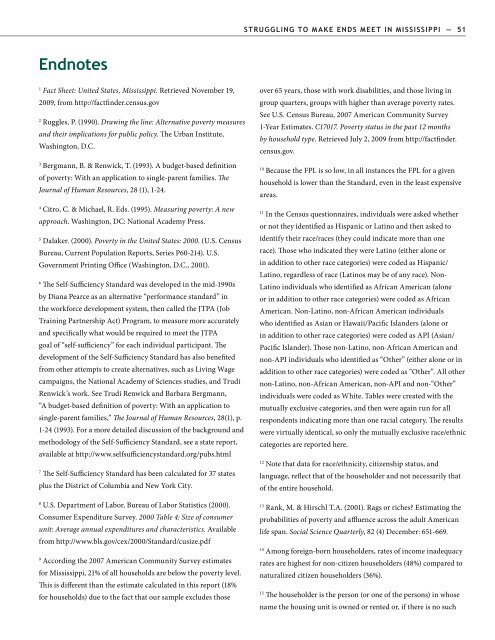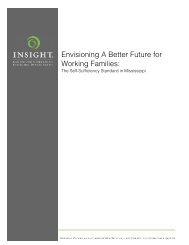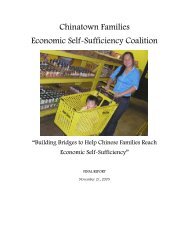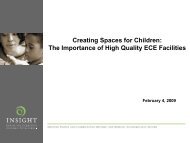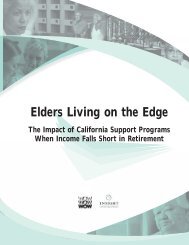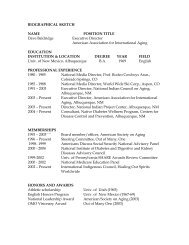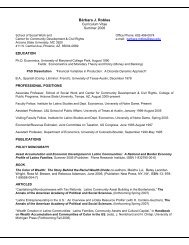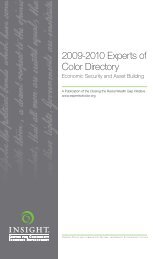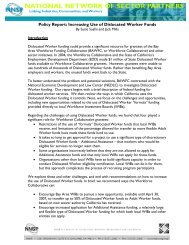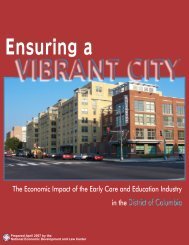Overlooked and Undercounted - Insight Center for Community ...
Overlooked and Undercounted - Insight Center for Community ...
Overlooked and Undercounted - Insight Center for Community ...
Create successful ePaper yourself
Turn your PDF publications into a flip-book with our unique Google optimized e-Paper software.
STRUGGLING TO MAKE ENDS MEET IN MISSISSIPPI — 51<br />
Endnotes<br />
1<br />
Fact Sheet: United States, Mississippi. Retrieved November 19,<br />
2009, from http://factfinder.census.gov<br />
2<br />
Ruggles, P. (1990). Drawing the line: Alternative poverty measures<br />
<strong>and</strong> their implications <strong>for</strong> public policy. The Urban Institute,<br />
Washington, D.C.<br />
3<br />
Bergmann, B. & Renwick, T. (1993). A budget-based definition<br />
of poverty: With an application to single-parent families. The<br />
Journal of Human Resources, 28 (1), 1-24.<br />
4<br />
Citro, C. & Michael, R. Eds. (1995). Measuring poverty: A new<br />
approach. Washington, DC: National Academy Press.<br />
5<br />
Dalaker. (2000). Poverty in the United States: 2000. (U.S. Census<br />
Bureau, Current Population Reports, Series P60-214). U.S.<br />
Government Printing Office (Washington, D.C., 2001).<br />
6<br />
The Self-Sufficiency St<strong>and</strong>ard was developed in the mid-1990s<br />
by Diana Pearce as an alternative “per<strong>for</strong>mance st<strong>and</strong>ard” in<br />
the work<strong>for</strong>ce development system, then called the JTPA (Job<br />
Training Partnership Act) Program, to measure more accurately<br />
<strong>and</strong> specifically what would be required to meet the JTPA<br />
goal of “self-sufficiency” <strong>for</strong> each individual participant. The<br />
development of the Self-Sufficiency St<strong>and</strong>ard has also benefited<br />
from other attempts to create alternatives, such as Living Wage<br />
campaigns, the National Academy of Sciences studies, <strong>and</strong> Trudi<br />
Renwick’s work. See Trudi Renwick <strong>and</strong> Barbara Bergmann,<br />
“A budget-based definition of poverty: With an application to<br />
single-parent families,” The Journal of Human Resources, 28(1), p.<br />
1-24 (1993). For a more detailed discussion of the background <strong>and</strong><br />
methodology of the Self-Sufficiency St<strong>and</strong>ard, see a state report,<br />
available at http://www.selfsufficiencyst<strong>and</strong>ard.org/pubs.html<br />
7<br />
The Self-Sufficiency St<strong>and</strong>ard has been calculated <strong>for</strong> 37 states<br />
plus the District of Columbia <strong>and</strong> New York City.<br />
8<br />
U.S. Department of Labor, Bureau of Labor Statistics (2000).<br />
Consumer Expenditure Survey. 2000 Table 4: Size of consumer<br />
unit: Average annual expenditures <strong>and</strong> characteristics. Available<br />
from http://www.bls.gov/cex/2000/St<strong>and</strong>ard/cusize.pdf<br />
9<br />
According the 2007 American <strong>Community</strong> Survey estimates<br />
<strong>for</strong> Mississippi, 21% of all households are below the poverty level.<br />
This is different than the estimate calculated in this report (18%<br />
<strong>for</strong> households) due to the fact that our sample excludes those<br />
over 65 years, those with work disabilities, <strong>and</strong> those living in<br />
group quarters, groups with higher than average poverty rates.<br />
See U.S. Census Bureau, 2007 American <strong>Community</strong> Survey<br />
1-Year Estimates. C17017. Poverty status in the past 12 months<br />
by household type. Retrieved July 2, 2009 from http://factfinder.<br />
census.gov.<br />
10<br />
Because the FPL is so low, in all instances the FPL <strong>for</strong> a given<br />
household is lower than the St<strong>and</strong>ard, even in the least expensive<br />
areas.<br />
11<br />
In the Census questionnaires, individuals were asked whether<br />
or not they identified as Hispanic or Latino <strong>and</strong> then asked to<br />
identify their race/races (they could indicate more than one<br />
race). Those who indicated they were Latino (either alone or<br />
in addition to other race categories) were coded as Hispanic/<br />
Latino, regardless of race (Latinos may be of any race). Non-<br />
Latino individuals who identified as African American (alone<br />
or in addition to other race categories) were coded as African<br />
American. Non-Latino, non-African American individuals<br />
who identified as Asian or Hawaii/Pacific Isl<strong>and</strong>ers (alone or<br />
in addition to other race categories) were coded as API (Asian/<br />
Pacific Isl<strong>and</strong>er). Those non-Latino, non-African American <strong>and</strong><br />
non-API individuals who identified as “Other” (either alone or in<br />
addition to other race categories) were coded as “Other”. All other<br />
non-Latino, non-African American, non-API <strong>and</strong> non-“Other”<br />
individuals were coded as White. Tables were created with the<br />
mutually exclusive categories, <strong>and</strong> then were again run <strong>for</strong> all<br />
respondents indicating more than one racial category. The results<br />
were virtually identical, so only the mutually exclusive race/ethnic<br />
categories are reported here.<br />
12<br />
Note that data <strong>for</strong> race/ethnicity, citizenship status, <strong>and</strong><br />
language, reflect that of the householder <strong>and</strong> not necessarily that<br />
of the entire household.<br />
13<br />
Rank, M. & Hirschl T.A. (2001). Rags or riches? Estimating the<br />
probabilities of poverty <strong>and</strong> affluence across the adult American<br />
life span. Social Science Quarterly, 82 (4) December: 651-669.<br />
14<br />
Among <strong>for</strong>eign-born householders, rates of income inadequacy<br />
rates are highest <strong>for</strong> non-citizen householders (48%) compared to<br />
naturalized citizen householders (36%).<br />
15<br />
The householder is the person (or one of the persons) in whose<br />
name the housing unit is owned or rented or, if there is no such


